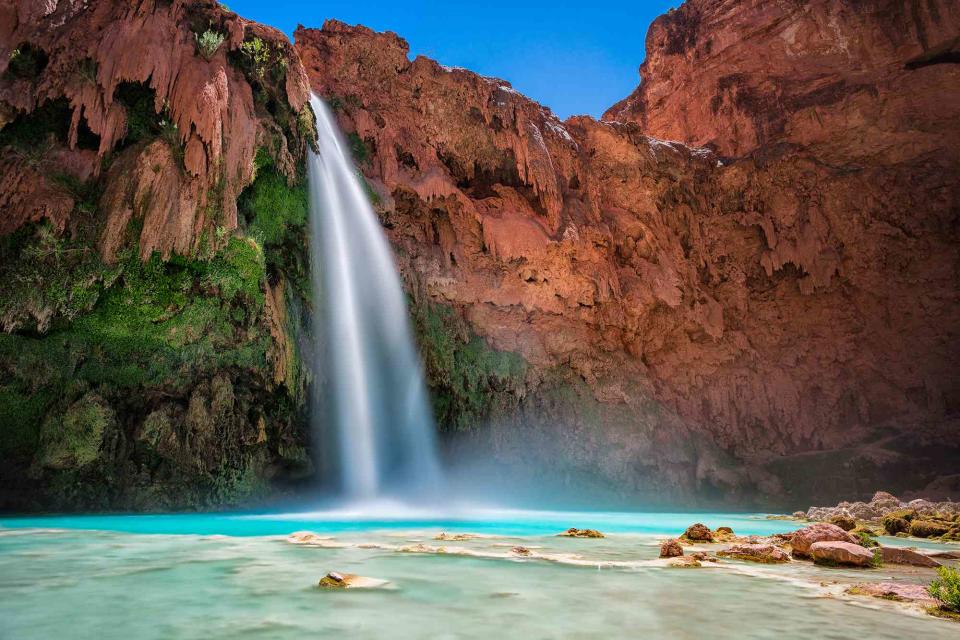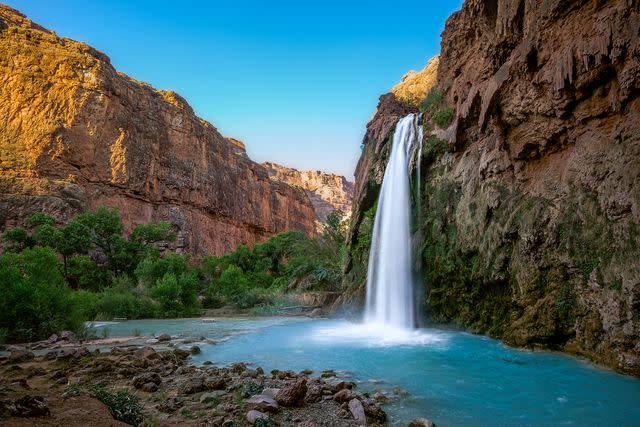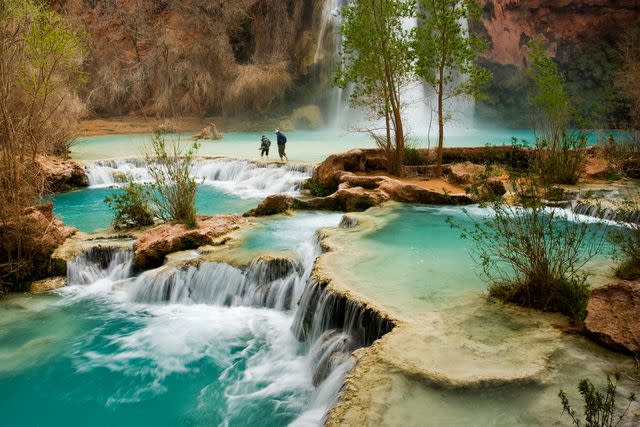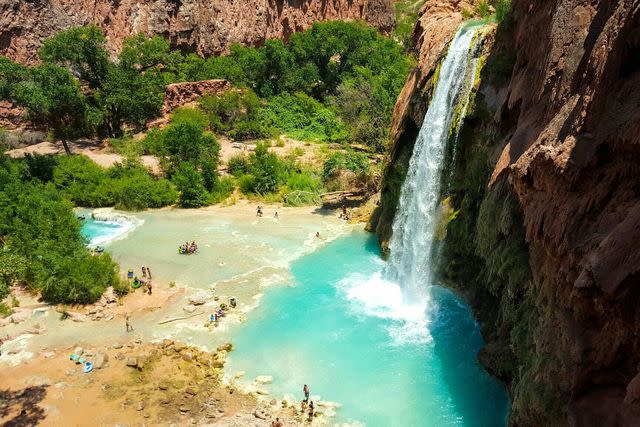Everything You Need to Know to Visit Havasu Falls — Including How to Get a Permit, What to See, and How to Be a Good Visitor
Here's what you need to know to plan a trip to Havasu Falls this year.

Kevin Boutwell/Getty Images
The beauty of Havasu Falls needs little explanation. The waterfall topples off fiery red rock and drops into a turquoise pool that is so bright it looks fake. It is a site people have traveled from all over the world to see and photograph — and after it closed in March 2020 for the pandemic and subsequent flooding, traveler hype has only increased.
This year, for the first time since early 2020, Havasu Falls is once again welcoming visitors — but it takes plenty of planning and a long hike to get there. The falls are located west of Grand Canyon National Park in Arizona — more specifically, the site is found on the Havasupai Reservation, a Native American reservation for the Havasupai people. The landscape, which is managed by the Havasupai, should be respected to ensure it remains in good condition for both the next group of travelers and the Tribe.
To that end, the number of visitors that can access Havasu Falls and the surrounding lands is restricted, and obtaining a permit takes luck — in addition to lots of planning. And travelers who obtain a coveted permit must be prepared to trek into the remote falls (or book a helicopter ride).
It’s a complicated process, and there is plenty of false information out there. We’ve outlined the basics below, but keep your research to websites run and maintained by the Havasupai — namely HavasupaiReservations.com and TheOfficialHavasupaiTribe.com.

Putt Sakdhnagool/Getty Images
When to Visit Havasu Falls
The official tourism season runs from February to November, but most travelers visit between May and September. During the heart of summer, June to August, the heat can be extreme, and rains and flooding can occur. The months of May and September typically offer slightly cooler weather, although it’s worth noting that the temperature of the turquoise pools found at the base of the falls is roughly 70 degrees all year long.
The forecast for Supai, the capital of the Havasupai Reservation, can be found on weather.com.
How to Get a Permit for Havasu Falls
A campground or lodge reservation — required for all visitors — includes all the necessary permits, tags, fees, taxes, and entry passes. So, in order to get a permit to visit Havasu Falls, you’ll need to book a campground or lodge reservation on HavasupaiReservations.com.
That said, reservations opened for the 2023 tourism season on February 1, 2023 and sold out quickly. Those who didn’t score a reservation and still want to visit Havasu Falls in 2023 can visit the official Havasupai reservation site each day at 8 a.m. (GMT-7) when reservations that were canceled or transferred are released.
It’s worth noting that you’ll need an account on HavasupaiReservations.com to make a reservation, so you’ll want to register on the site in advance so you can quickly claim an available reservation. If you’re traveling with a group, the reservation can be put under one person’s name.
Choosing Between the Campground and the Lodge
All visitors must book a stay at either the Havasupai Campground or the Havasupai Lodge. Both reservations include the permits needed to access Havasu Falls.
For 2023, all campground reservations are for four days and three nights and are $395 per person. The camping is dispersed, meaning you can camp wherever you want for about a mile along both sides of Havasu Creek. The campground is located between Havasu Falls and Mooney Falls, providing campers with easy and direct access to the landscape’s biggest sites. There are no designated or assigned campsites at the campground, but there are restrooms, picnic tables, and drinking water. Campfires and alcohol are not permitted.
Like the campground, all lodge reservations are for four days and three nights. The rate per room is $1,980, and each room has two queen beds that sleep four adults (making the per-person nightly rate $495 for a group of four). The lodge is located in the community of Supai and is a two-mile hike (around 45 minutes) from Havasu Falls. There is a store and cafe where travelers can purchase food. The Havasupai Lodge is currently closed but will open in July 2023.

anirav/Getty Images
Hiking Into the Havasupai Reservation and Havasu Falls
The falls, campground, and lodge are all located in a canyon, so you’ll leave your car at the top and hike down. Most travelers park at Hualapai Hilltop and begin the eight-mile descent to the community of Supai, where the Havasupai Lodge is located. Those with campground reservations will need to continue another two miles. There’s a handy map on the Havasupai website.
To avoid hauling all your gear in and out of the canyon, travelers can reserve a pack mule before their visit. The cost per pack mule is $400 round trip, and one pack mule can carry up to four 32-pound bags. There is also a helicopter service into the canyon.
What to See Besides Havasu Falls
Havasu Falls gets all the hype, but Navajo Falls above it and Mooney Falls and Beaver Falls below it are similarly spectacular. All hikers traveling to Havasu Falls will naturally pass Navajo Falls, which is a grand series of cascades and pools surrounded by lush vegetation.
Around a mile downstream from Havasu Falls is Mooney Falls, which is arguably the second most popular site. Mooney Falls is an impressive 100-foot waterfall that smashes into stunning travertine pools of blue-green water. Those looking to bypass the crowds know to go to Beaver Falls, which is around three miles from Havasu Falls and the Havasupai Campground. Beaver Falls is a series of swimmable pools fed by small cascades.
And finally, since the Havasupai Reservation sits within a canyon on the edge of Grand Canyon National Park, visitors can expect nonstop canyon and desert landscape views from the trail, campground, and falls.
Cultural Importance of the Havasupai Reservation and Havasu Falls
For many centuries, the Havasupai moved freely in and around the Grand Canyon. When the Havasupai Reservation was established in 1880, it effectively confined the Tribe to the land at the base of Havasu Canyon. The Tribe’s new space limitation restricted their ability to hunt, grow food, and support their growing community, yet it did include the area surrounding Havasu Falls, which was historically used for cremations. Even the name of the Havasupai Tribe comes from the turquoise, mineral-rich pools of water that gather at the base of the many falls along Havasu Creek.

Christian Bradshaw/Getty Images
Rules for Visitors to Havasu Falls
There are several rules for visitors who make the journey to the Havasupai Reservation and Havasu Falls. For campers, bear canisters and bags are a must to keep critters out, and campfires are not allowed. All visitors should know that alcohol is not allowed on the reservation and everything you bring in — including trash — must be packed out.
Where to Stay Nearby
Since the hike to the Havasupai Lodge and Campground is several miles, most travelers choose to stay overnight near the trailhead at Hualapai Hilltop. The go-to spot is Grand Canyon Caverns, which is located on Route 66 near Seligman, Arizona. The inn is just over an hour from Hualapai Hilltop and the trailhead into the canyon.
How to Get There
Part of Havasu Falls’ appeal is that it is hard to access — only those willing to put in the time to make advance reservations and hike in are rewarded with the beauty of the falls and the canyon.
The trailhead at Hualapai Hilltop is close to three hours by car from Flagstaff Pulliam Airport (FLG) and over 3.5 from Harry Reid International Airport (LAS) in Las Vegas.
For more Travel & Leisure news, make sure to sign up for our newsletter!
Read the original article on Travel & Leisure.

